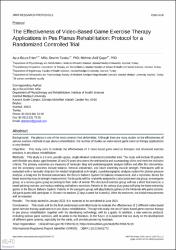| dc.contributor.author | Erten, Ayşe Büşra | |
| dc.contributor.author | Tarakçı, Devrim | |
| dc.contributor.author | Çaçan, Mehmet Akif | |
| dc.date.accessioned | 2023-10-18T08:25:55Z | |
| dc.date.available | 2023-10-18T08:25:55Z | |
| dc.date.issued | 2023 | en_US |
| dc.identifier.citation | Erten, A. B., Tarakçı, D. ve Çaçan, M. A. (2023). The effectiveness of video-based game exercise therapy applications in pes planus rehabilitation: Protocol for a randomized controlled trial. JMIR Research Protocols, 12. https://doi.org/10.2196/51772 | en_US |
| dc.identifier.issn | 1929-0748 | |
| dc.identifier.uri | https://doi.org/10.2196/51772 | |
| dc.identifier.uri | https://hdl.handle.net/20.500.12511/11601 | |
| dc.description.abstract | Background: Pes planus is one of the most common foot deformities. Although there are many studies on the effectiveness of various exercise methods in pes planus rehabilitation, the number of studies on video-based game exercise therapy applications is very limited. Objective: This study aims to evaluate the effectiveness of 2 video-based game exercise therapies and structured exercise practices in pes planus rehabilitation. Methods: This study is a 3-arm, parallel-group, single-blinded randomized controlled trial. The study will include 69 patients with flexible pes planus aged between 18 and 25 years who attend the orthopedics and traumatology clinic and meet the inclusion criteria. The primary outcomes are measures of navicular drop and pedobarographic analysis before and after the intervention, and the secondary outcomes include balance, femoral anteversion, and lower extremity muscle strength. Participants will be evaluated with a navicular drop test for medial longitudinal arch height, a pedobarographic analysis system for plantar pressure analysis, a Craig test for femoral anteversion, the Becure Balance System for balance measurement, and a myometer device for lower extremity muscle strength measurement. Participants will be randomly assigned to a structured exercise group, an exergame group, or a serious game group according to their order of arrival. The structured exercise group will use a short foot exercise, a towel-picking exercise, and various walking and balance exercises. Patients in the serious play group will play the lower extremity games in the Becure Balance System. Patients in the exergame group will play balance games on the Nintendo Wii game console. All participants will participate in 18 exercise sessions (3 days a week for 6 weeks). After the treatment, the initial measurements will be repeated. Results: The study started in January 2023. It is expected to be completed in June 2024. Conclusions: This study will be the first randomized controlled study to evaluate the effectiveness of 2 different video-based game exercise therapy applications in pes planus rehabilitation. Through this study, the use of video-based game exercise therapy in pes planus rehabilitation, together with the developing technology, will be a guide. In addition, a new exercise protocol, including serious game exercises, will be added to the literature. In the future, it is expected that our study on the development of different game systems, especially for the ankle, will provide pioneering feedback. | en_US |
| dc.language.iso | eng | en_US |
| dc.publisher | JMIR Publications Inc. | en_US |
| dc.rights | info:eu-repo/semantics/openAccess | en_US |
| dc.rights | Attribution 4.0 International | * |
| dc.rights.uri | https://creativecommons.org/licenses/by/4.0/ | * |
| dc.subject | Exergame | en_US |
| dc.subject | Pes Planus | en_US |
| dc.subject | Rehabilitation | en_US |
| dc.subject | Serious Game | en_US |
| dc.subject | Video-Based Game Therapy | en_US |
| dc.title | The effectiveness of video-based game exercise therapy applications in pes planus rehabilitation: Protocol for a randomized controlled trial | en_US |
| dc.type | article | en_US |
| dc.relation.ispartof | JMIR Research Protocols | en_US |
| dc.department | İstanbul Medipol Üniversitesi, Sağlık Bilimleri Enstitüsü, Fizyoterapi ve Rehabilitasyon Ana Bilim Dalı | en_US |
| dc.department | İstanbul Medipol Üniversitesi, Sağlık Bilimleri Fakültesi, Ergoterapi Bölümü | en_US |
| dc.department | İstanbul Medipol Üniversitesi, Tıp Fakültesi, Cerrahi Tıp Bilimleri Bölümü, Ortopedi ve Travmatoloji Ana Bilim Dalı | en_US |
| dc.authorid | 0000-0003-1218-7098 | en_US |
| dc.authorid | 0000-0001-9804-368X | en_US |
| dc.authorid | 0000-0003-2587-6327 | en_US |
| dc.identifier.volume | 12 | en_US |
| dc.relation.publicationcategory | Makale - Uluslararası Hakemli Dergi - Kurum Öğretim Elemanı | en_US |
| dc.identifier.doi | 10.2196/51772 | en_US |
| dc.institutionauthor | Erten, Ayşe Büşra | |
| dc.institutionauthor | Tarakçı, Devrim | |
| dc.institutionauthor | Çaçan, Mehmet Akif | |
| dc.identifier.wos | 001105606300001 | en_US |
| dc.identifier.scopus | 2-s2.0-85173135704 | en_US |
| dc.identifier.pmid | 37695657 | en_US |
| dc.identifier.scopusquality | Q2 | en_US |



















